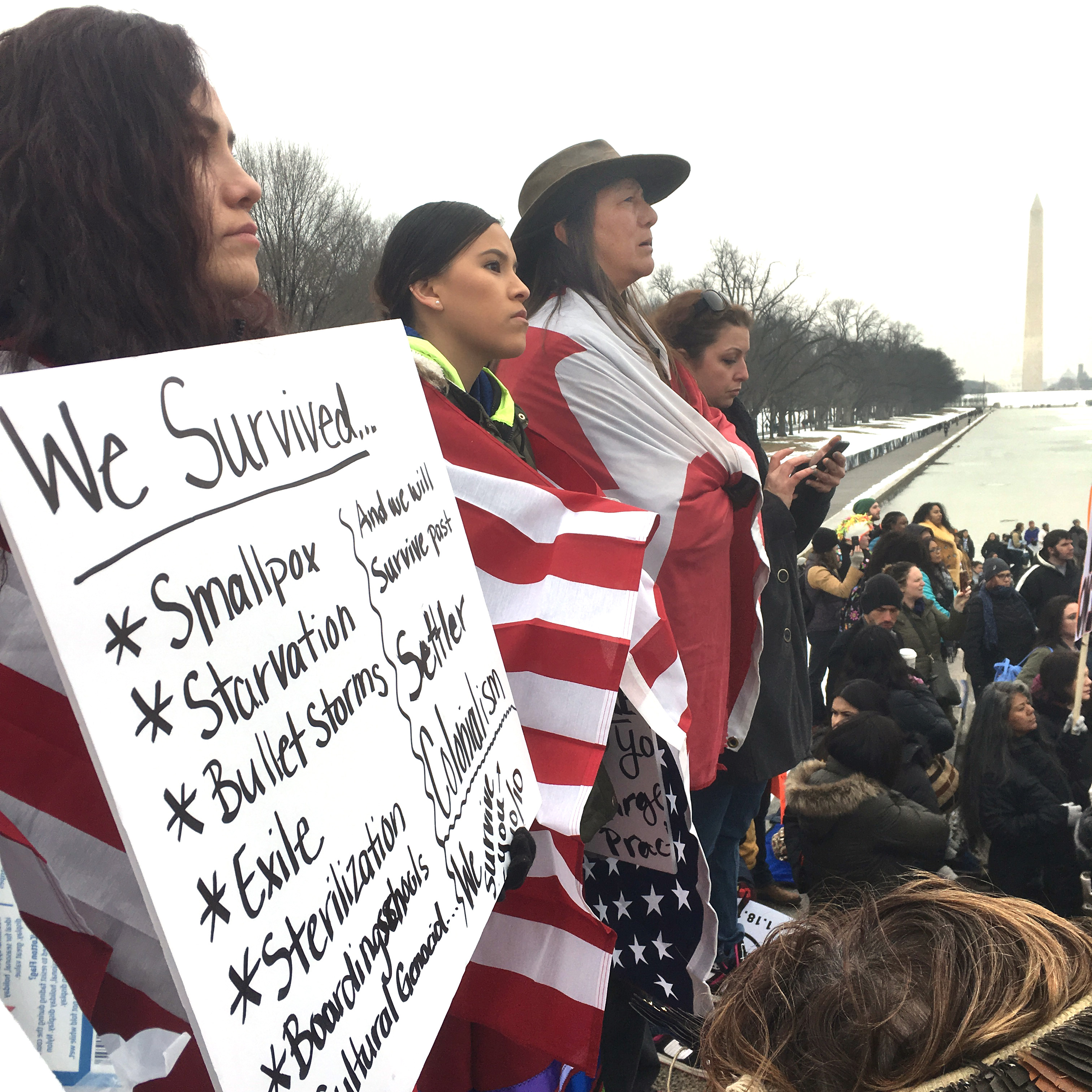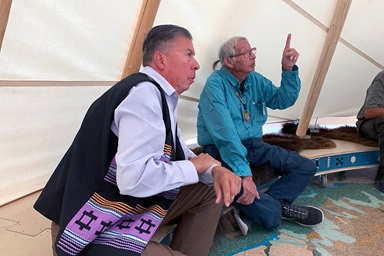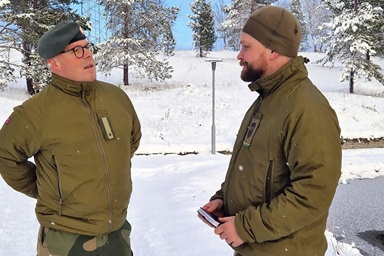The smell of burning sage and cedar wafted through the air, its smoke quickly blending in against the gray-sky background.
The Rev. David Wilson, along with thousands of others, put one foot in front of the other. Even as the smoke dissipated, the smell remained, clinging to nostrils and clothes.
The United Methodist pastor and others moved forward. The first-ever Indigenous Peoples March was underway.
Burning sage and cedar is used for cleansing and ceremonial purposes, Wilson said. Several people held sticks or pots filled with the dried plants, burning slowly, chanting and drumming down Constitution Avenue and onto the National Mall. They were headed to the Lincoln Memorial.
Wilson serves as the conference superintendent for the Oklahoma Indian Missionary Conference, a position similar to a bishop. He works with 87 churches and fellowships across four states, representing more than 6,800 people and 39 different tribes.
The conference traces its roots back to the 1820s, when indigenous peoples were removed from their lands in the Southeast and sent to “Indian territory,” Wilson said. Methodist evangelists had already done their work, so many people were Christian when they arrived, he said.
“We are the mother church of Methodism for the state of Oklahoma,” he said. “We’re very proud of that.”
A widely watched video of an incident during the Jan. 18 march created a furor. The video showed an Omaha elder beating a drum in front of a Covington Catholic High School student wearing a Make America Great Again hat, National Public Radio reported. They were surrounded by a predominantly white crowd of the teen’s classmates who were laughing and jeering. The students’ Kentucky high school apologized, but other videos, narratives and news reports emerged later that gave more context about what happened.
The Rev. Bryan Tener, the Oklahoma Indian Missionary Conference’s director of connectional ministries, came to the march to lift up the issues that affect the daily lives of indigenous communities.

Tener, a descendent of the Cheyenne and Arapaho tribes, said that access to health care and tribal rights to land, food and water and the need to raise a political voice were all important.
“Often, our political voice is silenced,” he said. “We’re here to let people know that we still exist.
“All over the world, indigenous peoples have had their cultures and voices wiped away,” he said. “Our identities have been stripped through colonialism. I think that God desires everyone to live into their full humanity, and when we deny someone’s humanity, we’re denying God.
“For us, as the Oklahoma Indian Missionary Conference, what we want to share is that God has created diverse people, beautiful people and that we stand with those who’ve been oppressed and marginalized.”
The Indigenous Peoples March was a grassroots effort to bring a rally to the nation’s capital and to educate people about the issues facing indigenous peoples around the world, organizers said.
“Indigenous people from North, Central and South America, Oceania, Asia, Africa and the Caribbean are a target of genocide,” event organizers said on their Facebook page. “Currently, many indigenous people are victims of voter suppression, divided families by walls and borders, an environmental holocaust, sex and human trafficking, and police/military brutality with little or no resources and awareness of this injustice.”
Wilson knows that concerns vary from tribe to tribe and from people to people. Some of the bigger issues for him include the environment and caring for “Mother Earth” and focusing attention on murdered and missing Native American women.

According to published reports, the National Crime Information Center found that in 2016 there were 5,712 reports of missing Native American women and girls.” NPR reported last year that “no federal agency has comprehensive data on how many indigenous women are murdered or missing.”
Wilson said the missing and murdered women are of particular concern. “It’s not quite epidemic, but it’s coming close. Not only do the women come up missing, but no one pays attention to their plight.”
This is especially notable in the northern tier states, such as Montana and North and South Dakota, he said, where a lot of human trafficking of Native American women takes place.
Wilson, a member of the Choctaw Nation of Oklahoma, said that it was critical for Native American Christians to be represented at the Indigenous Peoples March, and to be speaking out on these and other issues.
Wilson said he was thankful for the United Methodist connection, which made the trip possible for the nine-person delegation from the Oklahoma Indian Missionary Conference. Among those providing support were the Board of Church and Society, Commission on Religion and Race, United Methodist Committee on Relief and Oklahoma Conference.
What The United Methodist Church says
“So many people offered support, not only financially but also through sending emails or messages saying, ‘We’re praying for you,’ and ‘thank you for representing the church.’ It’s the connection in action,” Wilson said.
Amy Fry, a member of Wallingford United Methodist Church in Seattle, was at the march to lend her voice and support to the movement.
“I feel strongly about the indigenous people’s movement,” she said, adding that she’s attended other such marches in Seattle. “I hope we can solve the missing and murdered indigenous women’s issue.”
Chelsea Spyres, from the Peninsula-Delaware Conference and a student at Wesley Theological Seminary in Washington, was marching, too.
“I’m marching with my indigenous friends, who have been on this land long before my ancestors arrived,” she said. “It’s important for me to be present to just show up and hear the voices of our indigenous brothers and sisters — to listen and learn more.”
Alsgaard is managing editor in the Ministry of Communications for the Baltimore-Washington Conference. To get more United Methodist news, subscribe to the free Daily or Weekly Digests.
News contact: Vicki Brown, 615-742-5472 or [email protected].
Like what you're reading? Support the ministry of UM News! Your support ensures the latest denominational news, dynamic stories and informative articles will continue to connect our global community. Make a tax-deductible donation at ResourceUMC.org/GiveUMCom.




